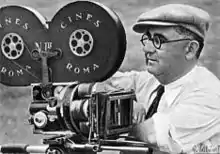Carlo Montuori | |
|---|---|
 | |
| Born | 3 August 1885 |
| Died | 4 March 1968 (aged 82) |
Carlo Montuori (3 August 1885 - 4 March 1968) was an Italian cinematographer and cameraman.
Born in Casacalenda, Campobasso, at twelve Montuori moved to Milan to live with his uncle, a photographer and a painter; in Milan he attended the Polytechnic University and followed courses in painting at the Brera Academy.[1] He approached cinema in 1907 working in the production company "Comerio & C." and debuting as an operator in Dalla pietà all'amore, a 1909 Luca Comerio's documentary film about the 1908 Messina earthquake.[1] At the same time Montuori started working at the photo studio Ganzini, where he learned the basics in the field of the use of artificial lighting.[1] Starting from 1911 Montuori was among the first in Italy to test the application of these techniques in film, inventing a device based on rudimentary arc lamps, made of carbon bound with wire and connected to the electric current through resistors.[1][2]
After collaborating with the Italian leading directors from the silent era such as Carmine Gallone and Augusto Genina, in 1925 he collaborated at the Fred Niblo's blockbuster Ben-Hur, and in 1929 he was the cinematographer of Sole, the directorial debut of Alessandro Blasetti, with whom he establishing a professional relationship that lasted for eight films.[3]
After the war, Montuori "had a major role in the figurative culture of first neo-realism",[1] often collaborating with Luigi Zampa and winning a silver ribbon for best cinematography for his work in Vittorio De Sica's Bicycle Thieves.[4] His son Mario was also a cinematographer.[1]
Selected filmography
- Marco Visconti (1925)
- Goodbye Youth (1927)
- Miryam (1929)
- Sun (1929)
- Mother Earth (1931)
- The Man with the Claw (1931)
- The Paw (1931)
- The Table of the Poor (1932)
- The Blue Fleet (1932)
- Your Money or Your Life (1932)
- The Missing Treaty (1933)
- Seconda B (1934)
- The Last of the Bergeracs (1934)
- Unripe Fruit (1934)
- Stadium (1934)
- Golden Arrow (1935)
- Thirty Seconds of Love (1936)
- The Dance of Time (1936)
- The Ferocious Saladin (1937)
- Abandon All Hope (1937)
- For Men Only (1938)
- A Lady Did It (1938)
- Pride (1938)
- They've Kidnapped a Man (1938)
- Frenzy (1939)
- Goodbye Youth (1940)
- Pirates of Malaya (1941)
- The Two Tigers (1941)
- Souls in Turmoil (1942)
- Sleeping Beauty (1942)
- The Countess of Castiglione (1942)
- Street of the Five Moons (1942)
- Yes, Madam (1942)
- Farewell Love! (1943)
- Departure at Seven (1946)
- The Courier of the King (1947)
- The White Primrose (1947)
- To Live in Peace (1947)
- Bicycle Thieves (1948)
- Prelude to Madness (1948)
- Alarm Bells (1949)
- Chains (1949)
- The Bread Peddler (1950)
- The Black Captain (1951)
- Rome-Paris-Rome (1951)
- Mamma Mia, What an Impression! (1951)
- Lieutenant Giorgio (1952)
- The Dream of Zorro (1952)
- The Enemy (1952)
- Passionate Song (1953)
- What Scoundrels Men Are! (1953)
- Via Padova 46 (1953)
- Count Max (1957)
References
- 1 2 3 4 5 6 Stefano Masi, Storie della luce: i film, la vita, le avventure, le idee di 200 operatori italiani, L'Aquila 1983, pp. 153-56.
- ↑ Alberto Lorenzi, Milano, il nostro secolo: Letteratura, teatro, divertimenti e personaggi del '900 milanese, Bramante, 1969, p. 87.
- ↑ Gianni Canova. Enciclopedia del cinema. Garzanti Libri, 2009. p. 831.
- ↑ Enrico Lancia. I premi del cinema. Gremese Editore, 1998. p. 228.